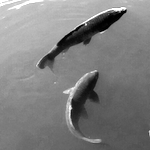Navigation on the water's surface remains a serious challenge for bio-inspired robotics.
Indeed, due to their low axial moment of inertia, swimming slender robots are particularly sensitive to disturbances (wave, wind..etc) and can exhibit a strong rolling motion during slow maneuvers. In contrast, snakes can perfom complex maneuvers while preserving their stability.
How can snakes stabilize actively their heads at the water's surface? Yet, we don't know.
My PhD thesis aims at replicating the exceptionnal sense of balance of aquatic snakes by developing a new snake-like robot taking inspiration from a snake called Agkistrodon piscivorus (cottonmouth)
In the poster, I will :
-> report our first observations of the mechanisms/strategies used by snakes to stabilize themselves on the water's surface.
-> introduce our new robot NATRIX equipped with an additionnal degree of freedom dedicated to the stabilization process based on our observations. We explain how this new degree of freedom pave the way to active strategy of gaze control and body stabilization.
-> present preliminary experimental results demonstrating the presence of the rolling motion as well as the future strategies to prevent this motion.
|
|
|
|
New snake-like robot to explore the stability and instability of slender swimmers at the water's surface
1 : Robotique Et Vivant Laboratoire des Sciences du Numérique de Nantes
|

 PDF version
PDF version
